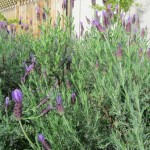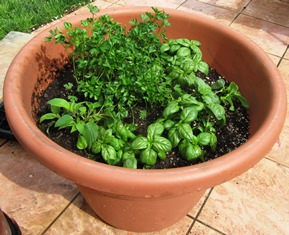Backyard Herbal–Hair Rinses and Hot Oil Treatments
In college, I often washed my then waist-long auburn hair with apple cider vinegar to keep the locks healthy and shining. And years ago, I discovered the decadent pleasure of a hot rosemary oil treatment and scalp massage that uses lavender oil.
If you grow your own herbs, making hair-care products couldn’t be easier.
The following are simple recipes you can make with home grown herbs and essential oils available in health food stores.
Apple Cider Vinegar Rinse Recipe: 4 cups of warm water to 1 cup apple cider vinegar. After you’ve washed the shampoo out of your hair, use the vinegar water as your final rinse.
Alternatively, you could add a couple of ounces of your favorite herbs like lavender, lemon balm, chamomile, or rosemary sprigs along with scented essential oils to impart shine and fragrance to your hair. Rosemary is also good for promoting hair and scalp health.
Rosemary Rinse Recipe: 4 cups of boiling water poured over 2 ounces of rosemary springs. Let set overnight under a lid or cover. The next day, strain out the rosemary sprigs and add to the liquid 10.5 ounces of apple cider vinegar and 10 drops of rosemary essential oil. Wash your hair, rinse, and as a final step pour through your hair the rosemary rinse.
For dry hair and scalp, create an oil treatment that you can do once every three weeks or a on a monthly basis. You’ll need rosemary, lavender, and a bit of tea tree oil (which possesses chemicals that may kill bacteria and fungus and reduce dandruff).
Hot Herbal Oil Treatment: 2 drops each of the following herbal oils–rosemary, tea tree, lavender–in 6 tablespoons of coconut oil. Thoroughly combine in a dark bottle, seal, and store. When you are ready for your hot oil treatment, sparingly apply the oil to strands of dry hair until all is lightly coated, not saturated. Cover with a hot towel for 15 to 20 minutes. Remove the towel and wash with shampoo as usual.
________________________________________________________
If you love all things natural, country, and homemade AND you enjoy a cozy mystery, check out my novels available online at Amazon.com, Barnes & Noble, Walmart, and other retail outlets as well as in bookstores everywhere.
For my newest novel, A HIVE OF HOMICIDES, click on the link: http://tinyurl.com/ya5vhhpm
Heirloom Herbs for the Kitchen
The green stalks of the red and yellow onions I planted in late summer are now up about a foot in a raised bed. The garlic that I planted around the same time is also poking up. Having onions, garlic, and fresh culinary herbs available year-round is not impossible in the Bay Area’s mild climate, especially when they are grown in cold frames, protected areas, and raised beds.
Some will re-seed themselves in the growing beds or around your yards. We’ve got Greek oregano and chives growing all over the place. Some of my favorites herbs include basil, cilantro, chervil, chives, dill, fennel, lemon balm, lavender, oregano, mint, marjoram, rosemary, thyme, parsley, sage, and savory.
We also grow a few ornamental herbs such as borage, hyssop, and catnip (for our new kitty), tea herbs (chamomile and mint), and medicinal herbs (like echinacea).
Herbs are easy to grow. Their blooms will attract insects beneficial to the garden. Butterflies and hummingbirds are also attracted. And herbs don’t need much–light, and porous soil, warmth, and decent drainage. For a light feeding of the herbs, we make chicken poop tea. With so many varieties of herbs available, why not tuck a few in your garden or in containers in a protected but sunny and warm area of your patio to enjoy in your culinary creations?
 Facebook
Facebook Goodreads
Goodreads LinkedIn
LinkedIn Meera Lester
Meera Lester Twitter
Twitter








